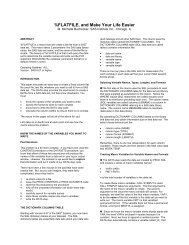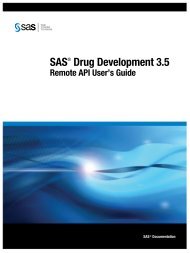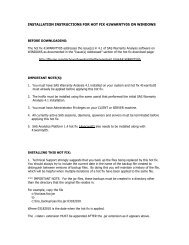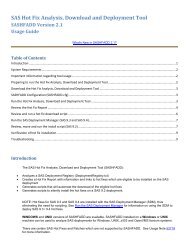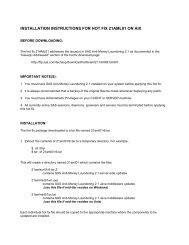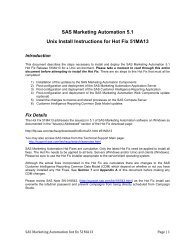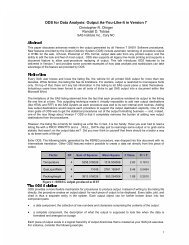Installing Platform Product Suite™ for SAS® (Unix) - Ftp Sas
Installing Platform Product Suite™ for SAS® (Unix) - Ftp Sas
Installing Platform Product Suite™ for SAS® (Unix) - Ftp Sas
You also want an ePaper? Increase the reach of your titles
YUMPU automatically turns print PDFs into web optimized ePapers that Google loves.
<strong>Installing</strong> <strong>Plat<strong>for</strong>m</strong> <strong>Product</strong> Suite<br />
<strong>for</strong> <strong>SAS®</strong> (<strong>Unix</strong>)<br />
Version 3.0<br />
April 18, 2006<br />
Contents ◆ “Introduction” on page 3<br />
◆ “Supported Systems” on page 5<br />
◆ “Installation Directories” on page 7<br />
◆ “Pre-Installation Requirements” on page 8<br />
◆ “Determine Hosts on which to Install LSF” on page 9<br />
◆ “Prepare Shares to Install LSF on a File Server” on page 10<br />
◆ “Install the <strong>Plat<strong>for</strong>m</strong> Process Manager Software” on page 11<br />
◆ “Using 64-bit Hardware in 32-bit Kernel Mode on an AIX5 <strong>Plat<strong>for</strong>m</strong>” on page 13<br />
◆ “<strong>Installing</strong> Library Patch Upgrade <strong>for</strong> Solaris 2.7 64-bit Machine” on page 14<br />
◆ “Start Up LSF” on page 16<br />
◆ “Check LSF Status” on page 18<br />
◆ “Find out Cluster Status (lsid and lsload)” on page 19<br />
◆ “Start the Process Manager Components” on page 23
Copyright<br />
We’d like to hear<br />
from you<br />
Trademarks<br />
© 1994-2005 <strong>Plat<strong>for</strong>m</strong> Computing Corporation<br />
All rights reserved.<br />
You can help us make this manual better by telling us what you think of the content,<br />
organization, and usefulness of the in<strong>for</strong>mation. If you find an error, or just want to make a<br />
suggestion <strong>for</strong> improving this manual, please address your comments to doc@plat<strong>for</strong>m.com.<br />
Your comments should pertain only to <strong>Plat<strong>for</strong>m</strong> LSF documentation. For product support,<br />
contact support@plat<strong>for</strong>m.com.<br />
Although the in<strong>for</strong>mation in this document has been carefully reviewed, <strong>Plat<strong>for</strong>m</strong> Computing<br />
Corporation (“<strong>Plat<strong>for</strong>m</strong>”) does not warrant it to be free of errors or omissions. <strong>Plat<strong>for</strong>m</strong><br />
reserves the right to make corrections, updates, revisions or changes to the in<strong>for</strong>mation in this<br />
document.<br />
UNLESS OTHERWISE EXPRESSLY STATED BY PLATFORM, THE PROGRAM DESCRIBED IN THIS<br />
DOCUMENT IS PROVIDED “AS IS” AND WITHOUT WARRANTY OF ANY KIND, EITHER EXPRESSED<br />
OR IMPLIED, INCLUDING, BUT NOT LIMITED TO, THE IMPLIED WARRANTIES OF<br />
MERCHANTABILITY AND FITNESS FOR A PARTICULAR PURPOSE. IN NO EVENT WILL PLATFORM<br />
COMPUTING BE LIABLE TO ANYONE FOR SPECIAL, COLLATERAL, INCIDENTAL, OR<br />
CONSEQUENTIAL DAMAGES, INCLUDING WITHOUT LIMITATION ANY LOST PROFITS, DATA, OR<br />
SAVINGS, ARISING OUT OF THE USE OF OR INABILITY TO USE THIS PROGRAM.<br />
® LSF is a registered trademark of <strong>Plat<strong>for</strong>m</strong> Computing Corporation in the United States and in<br />
other jurisdictions.<br />
PLATFORM COMPUTING, and the PLATFORM, and LSF logos are trademarks of <strong>Plat<strong>for</strong>m</strong><br />
Computing Corporation in the United States and in other jurisdictions.<br />
SAS and all other SAS Institute Inc. product or service names are registered trademarks or<br />
trademarks of SAS Institute Inc. in the USA and other countries.<br />
UNIX is a registered trademark of The Open Group.<br />
Other products or services mentioned in this document are identified by the trademarks or<br />
service marks of their respective owners.<br />
2<br />
<strong>Installing</strong> <strong>Plat<strong>for</strong>m</strong> Suite <strong>for</strong> SAS (UNIX)
Introduction<br />
Assumptions<br />
Technical Support<br />
<strong>Installing</strong> <strong>Plat<strong>for</strong>m</strong> <strong>Product</strong> Suite <strong>for</strong> <strong>SAS®</strong> (<strong>Unix</strong>)<br />
This document describes how to install the software required to run the<br />
<strong>Plat<strong>for</strong>m</strong> <strong>Product</strong> Suite <strong>for</strong> SAS software (“<strong>Product</strong> Suite <strong>for</strong> SAS”) with the<br />
SAS Management Console ® software on UNIX hosts. The <strong>Product</strong> Suite <strong>for</strong> SAS<br />
software includes the Process Manager Server and Client, and the<br />
<strong>Plat<strong>for</strong>m</strong> LSF ® software (“LSF”). Each of these components is required to run<br />
jobs using the <strong>Product</strong> Suite <strong>for</strong> SAS. A separate document describes how to<br />
install <strong>Plat<strong>for</strong>m</strong> Grid Management Service .<br />
The Process Manager Server controls the submission of jobs to LSF, managing<br />
any dependencies between the jobs.<br />
LSF dispatches all jobs submitted to it by the Process Manager Server, and<br />
returns the status of each jobs to the Process Manager Server. LSF also manages<br />
any resource requirements and per<strong>for</strong>ms load balancing within the compute<br />
cluster.<br />
The Process Manager Client allows you to monitor your workload as it runs.<br />
You can install all of the components on a single host, or you can install the<br />
Process Manager Server and LSF on separate hosts. This document describes<br />
how to install all components on a single host.<br />
For an overview of the Process Manager components, see the introductory<br />
chapter in Administering Process Manager.<br />
The following instructions assume that:<br />
◆<br />
◆<br />
You will install LSF and the Process Manager Server and Client on a single<br />
UNIX host. This host will act as the central point of control <strong>for</strong> a cluster of<br />
LSF hosts that actually run the jobs.<br />
You are creating an LSF cluster composed of only UNIX hosts. There will<br />
be no Windows hosts in your cluster.<br />
Should you encounter problems or have questions regarding the use of LSF<br />
and scheduling jobs from SAS Management Console, please contact SAS<br />
directly. You can use one of the following methods to contact the SAS<br />
Technical Support staff.<br />
1 Online problem/question submission:<br />
http://support.sas.com/techsup/contact/track_intro.html<br />
Choose SAS Management Console as the '<strong>Product</strong>' value.<br />
2 E-mail problem/question submission via EMITS facility:<br />
http://support.sas.com/techsup/contact/emits.html<br />
Choose SAS Management Console as the '<strong>Product</strong>' value.<br />
3 Telephone Support In<strong>for</strong>mation <strong>for</strong> North America:<br />
http://support.sas.com/techsup/contact/telephone_support.ht<br />
ml<br />
<strong>Installing</strong> <strong>Plat<strong>for</strong>m</strong> Suite <strong>for</strong> SAS (UNIX) 3
Introduction<br />
4 If you are not based in North America, use the links in the following URL<br />
<strong>for</strong> in<strong>for</strong>mation on how to contact other SAS Technical Support offices<br />
around the world:<br />
http://support.sas.com/techsup/contact/index.html<br />
While any SAS software user may contact Technical Support, priority is given<br />
to designated SAS support personnel at your site. (Note, you can use webbased<br />
<strong>for</strong>ms to find out who the SAS support personnel are at your site or redesignate<br />
SAS support personnel at your site using links from this URL:<br />
http://support.sas.com/techsup/contact/index.html<br />
4<br />
<strong>Installing</strong> <strong>Plat<strong>for</strong>m</strong> Suite <strong>for</strong> SAS (UNIX)
<strong>Installing</strong> <strong>Plat<strong>for</strong>m</strong> <strong>Product</strong> Suite <strong>for</strong> <strong>SAS®</strong> (<strong>Unix</strong>)<br />
Supported Systems<br />
SAS Management Console version<br />
SAS 9.1 Service Pack 3 or higher<br />
LSF version and plat<strong>for</strong>ms<br />
LSF version 6.0 on the following UNIX plat<strong>for</strong>ms:<br />
◆<br />
Sun SPARC systems running Solaris 2.7, 2.8, or 2.9 64-bit<br />
Solaris 2.7 requires a Sun Microsystem patch upgrade. See “<strong>Installing</strong> Library<br />
Patch Upgrade <strong>for</strong> Solaris 2.7 64-bit Machine” on page 14.<br />
◆ Solaris 2.10 on Sparc, 64-bit<br />
◆ SGI IRIX 6.5.8<br />
◆ Alpha 5 Tru64<br />
◆ HP TRU64 5.1<br />
◆ AIX 5.1, 5.3 64-bit (fileset xlC.aix50.rte must be at level 6.0.0.0 or later)<br />
◆ HP-UX 11.11, 11.23 IA-64<br />
◆ HP-UX 11 PA-RISC 64-bit<br />
◆ Linux2.4 glibc2.3 Itanium 64-bit<br />
◆ Linux2.4 glibc2.3 x86 32-bit<br />
◆ Linux2.6 SLES9 and RHEL4 on x86<br />
◆ Linux2.6 SLES9 and RHEL4 on AMD64<br />
◆ Linux2.6 SLES9 and RHEL4 on EM64T<br />
Process Manager Server requirements<br />
It is recommended that you install the Process Manager Server software on a<br />
dedicated machine.<br />
The Process Manager Server software must be installed on an LSF server host,<br />
but it is recommended that it not be an LSF master host.<br />
The Process Manager Server software runs on the following UNIX operating systems:<br />
◆ SGI IRIX 6.5.8<br />
◆ Alpha 5 Tru64<br />
◆ HP TRU64 5.1<br />
◆ AIX 5.1, 5.3 64-bit (fileset xlC.aix50.rte must be at level 6.0.0.0 or later)<br />
◆ HP-UX 11.11, 11.23 IA-64<br />
◆ HP-UX 11 PA-RISC 64-bit<br />
◆ Solaris 2.7, 2.8, 2.9 64-bit<br />
◆ Solaris 2.10 on Sparc, 64-bit<br />
◆ Linux2.4 glibc2.3 Itanium 64-bit<br />
◆ Linux2.4 glibc2.3 x86 32-bit<br />
◆ Linux2.6 SLES9 and RHEL4 on x86<br />
◆ Linux2.6 SLES9 and RHEL4 on AMD64<br />
<strong>Installing</strong> <strong>Plat<strong>for</strong>m</strong> Suite <strong>for</strong> SAS (UNIX) 5
Supported Systems<br />
◆ Linux2.6 SLES9 and RHEL4 on EM64T<br />
J2RE 1.4 (Java Runtime Environment) is installed with the Process Manager Server.<br />
The Process Manager Server requires the following:<br />
◆<br />
◆<br />
Approximately 135 MB free disk space <strong>for</strong> installation, and an additional 2 KB per<br />
job to handle jobs running simultaneously<br />
256 MB RAM <strong>for</strong> processing purposes<br />
6<br />
<strong>Installing</strong> <strong>Plat<strong>for</strong>m</strong> Suite <strong>for</strong> SAS (UNIX)
Installation Directories<br />
<strong>Installing</strong> <strong>Plat<strong>for</strong>m</strong> <strong>Product</strong> Suite <strong>for</strong> <strong>SAS®</strong> (<strong>Unix</strong>)<br />
The Process Manager and LSF installation produces the following directory structure:<br />
◆<br />
◆<br />
◆<br />
◆<br />
LSF_TOP is the directory in which LSF files are installed. For example:<br />
/usr/local/lsf<br />
Generally, LSF_TOP is mounted from a file server and all files associated with LSF<br />
(state files, binaries <strong>for</strong> the different architectures, configuration files) are stored in<br />
this file share.<br />
Machine-independent files are independent of the host type, and are shared by all<br />
host types (man pages, configuration files, include files, examples, etc.)<br />
Machine-dependent files are installed under LSF_TOP/6.0/plat<strong>for</strong>m_name.<br />
These directories and the files underneath represent the machine- dependent files.<br />
Machine-dependent files are specific to a particular host type and are the LSF<br />
command binaries, server daemons, libraries, and utilities.<br />
JS_TOP is the directory in which the Process Manager Server and Client files are<br />
installed. For example:<br />
/usr/local/pm<br />
<strong>Installing</strong> <strong>Plat<strong>for</strong>m</strong> Suite <strong>for</strong> SAS (UNIX) 7
Pre-Installation Requirements<br />
Pre-Installation Requirements<br />
❏<br />
❏<br />
❏<br />
❏<br />
License files provided to you by SAS, which license both LSF and the Process Manager<br />
Server.<br />
A shared file system <strong>for</strong> the hosts. The shared file system needs to be writable by<br />
root during the installation. See “Determine Hosts on which to Install LSF” on<br />
page 9 <strong>for</strong> details on share management.<br />
The installation must be per<strong>for</strong>med as root. This includes the distribution installation<br />
as well as the host setup steps. The root account must be able to write into the file<br />
system mounted at LSF_TOP.<br />
During installation, you will be required to provide an LSF primary administrator<br />
account. You can use an existing user account, or you can create a new account. The<br />
default is lsfadmin.<br />
This account must:<br />
❖ Exist on all hosts in the LSF cluster<br />
❖ Have the same UID (user id) on each host in the cluster<br />
Create a dedicated primary LSF administrator account to allow more than one<br />
person to modify the configuration files. Assigning an individual user account as the<br />
LSF administrator prevents anyone else from modifying the configuration.<br />
CAUTION<br />
Do not configure the root account as the primary LSF administrator.<br />
8<br />
<strong>Installing</strong> <strong>Plat<strong>for</strong>m</strong> Suite <strong>for</strong> SAS (UNIX)
Determine Hosts on which to Install LSF<br />
<strong>Installing</strong> <strong>Plat<strong>for</strong>m</strong> <strong>Product</strong> Suite <strong>for</strong> <strong>SAS®</strong> (<strong>Unix</strong>)<br />
There are two scenarios <strong>for</strong> installing LSF. Pick the one that best suits your<br />
environment.<br />
Install LSF locally on one host<br />
Install LSF on a file server<br />
Install LSF locally on one host and run LSF only on one host. If this is how you plan to<br />
install LSF, there is no need to export or mount a file system. LSF can be installed in a<br />
local directory such as /usr/local/lsf.<br />
Proceed to “Install the <strong>Plat<strong>for</strong>m</strong> Process Manager Software” on page 11.<br />
The file server that you select to install LSF can be:<br />
◆ A host in the LSF cluster that shares its distribution through NFS<br />
For example, there are two hosts in the cluster, hostA and hostB.<br />
❖ On hostA, the directory /usr/local/lsf is shared by exporting.<br />
❖ On hostB, /usr/local/lsf is mounted from hostA:/usr/local/lsf.<br />
◆ A dedicated server that is not part of the LSF cluster, and is used to store files. This<br />
configuration is used <strong>for</strong> larger clusters of 10 or more hosts, or if you want the added<br />
reliability and availability of a dedicated file server.<br />
For instructions on preparing the shares, proceed to “Prepare Shares to Install LSF on<br />
a File Server” on page 10.<br />
<strong>Installing</strong> <strong>Plat<strong>for</strong>m</strong> Suite <strong>for</strong> SAS (UNIX) 9
Prepare Shares to Install LSF on a File Server<br />
Prepare Shares to Install LSF on a File Server<br />
Prerequisites <strong>for</strong> creating shares<br />
Regardless of whether you install on one host and share the distribution or whether you<br />
install on a dedicated server, the share must be set up so that root can write to the file<br />
system from the client. This is controlled with the root option of the Solaris share<br />
command, or the exportfs command in other UNIX plat<strong>for</strong>ms such as HP-UX.<br />
Create and share the LSF directories on the file server<br />
1 Log on to the file server host as root.<br />
2 Create the share:<br />
Solaris<br />
a Edit the /etc/dfs/dfstab file and add the line:<br />
share -F nfs -o rw,root=client1:client2 -d "LSF share"<br />
/export/lsf<br />
b Run the command shareall.<br />
Other UNIX plat<strong>for</strong>ms:<br />
a Edit the /etc/exports file and add the line:<br />
/export/lsf -root=client1:client2<br />
b If the host has not shared a file system be<strong>for</strong>e, you may need to start the NFS<br />
service using a script in /etc/init.d, /sbin/init.d.<br />
c Run the command:<br />
exportfs /export/lsf<br />
3 Make sure the NFS service is started and that NFS will start at boot.<br />
On many systems it is possible to share a file system but that will not automatically<br />
start NFS.<br />
Mount directories on LSF hosts<br />
Repeat the following steps on each LSF host.<br />
1 Log on as root to an LSF host that will be running LSF jobs.<br />
2 Edit the /etc/fstab file (/etc/vfstab on Solaris) and add an entry such as:<br />
fileserver:/export/lsf /usr/local/lsf nfs hard,bg,intr 0 0<br />
Refer to your local man pages <strong>for</strong> fstab and mount to see the local <strong>for</strong>mat. The<br />
options 'hard,bg,intr' are recommended but not mandatory.<br />
3 Make sure the /usr/local/lsf directory exists on the host.<br />
4 Mount the directory. Run the command:<br />
mount /usr/local/lsf<br />
Where to go next “Install the <strong>Plat<strong>for</strong>m</strong> Process Manager Software” on page 11<br />
10<br />
<strong>Installing</strong> <strong>Plat<strong>for</strong>m</strong> Suite <strong>for</strong> SAS (UNIX)
<strong>Installing</strong> <strong>Plat<strong>for</strong>m</strong> <strong>Product</strong> Suite <strong>for</strong> <strong>SAS®</strong> (<strong>Unix</strong>)<br />
Install the <strong>Plat<strong>for</strong>m</strong> Process Manager Software<br />
Prepare the license files<br />
Prepare distribution files<br />
The following instructions assume you are installing both LSF and Process Manager<br />
together on the same UNIX host.<br />
1 “Prepare the license files” on page 11<br />
2 “Prepare distribution files” on page 11<br />
3 “Edit install.config” on page 12<br />
4 “Run the install script” on page 15<br />
5 “Set up server hosts with hostsetup” on page 15<br />
Use the license files obtained from SAS and copy the contents into a file where both<br />
LSF and Process Manager can access their license in<strong>for</strong>mation. For example, in a<br />
location available to both, create a file called license.dat.<br />
The Process Manager distribution files are located on a CD labeled <strong>Plat<strong>for</strong>m</strong> <strong>Product</strong><br />
Suite <strong>for</strong> SAS (<strong>for</strong> UNIX) in the root directory.<br />
1 Log in as root to one of the hosts that will be running LSF jobs.<br />
2 Mount the <strong>Plat<strong>for</strong>m</strong> <strong>Product</strong> Suite <strong>for</strong> SAS CD. For example: on /mnt/cdrom.<br />
3 If the SAS Software Navigator was used to extract the package, then you have a<br />
directory containing the installation files. For example, <strong>for</strong> AIX, the directory is<br />
called pm3.0_sas_aix5.tar/pm3.0_sas_pinstall. This directory contains<br />
the following:<br />
❖ install.config—the configuration file where you define your installation<br />
prior to installing<br />
❖ jsinstall—the install script <strong>for</strong> installing both LSF and the Process<br />
Manager Server and Client<br />
Otherwise, locate the package <strong>for</strong> your operating system and unpack it. For example,<br />
<strong>for</strong> AIX, you need the following file:<br />
pm3.0_sas_aix5.tar<br />
Extract the file as follows:<br />
# tar xvf pm3.0_sas_aix5.tar<br />
This creates a directory called pm3.0_sas_pinstall, containing the following:<br />
❖<br />
❖<br />
install.config—the configuration file where you define your installation<br />
prior to installing<br />
jsinstall—the install script <strong>for</strong> installing both LSF and the Process<br />
Manager Server and Client<br />
<strong>Installing</strong> <strong>Plat<strong>for</strong>m</strong> Suite <strong>for</strong> SAS (UNIX) 11
Install the <strong>Plat<strong>for</strong>m</strong> Process Manager Software<br />
Edit install.config<br />
1 Change to the pm3.0_sas_pinstall directory:<br />
# cd pm3.0_sas_pinstall<br />
2 As an administrator, edit install.config to define your configuration.<br />
Remove the comment symbol (#) and set values <strong>for</strong> the following parameters:<br />
a JS_TOP<br />
Specify the full path to the Process Manager directory. For example:<br />
JS_TOP=/usr/share/js<br />
b JS_HOST<br />
Specify the fully-qualified host name of the Process Manager Server host. For<br />
example:<br />
JS_HOST=hostB.plat<strong>for</strong>m.com<br />
c JS_PORT=1966<br />
Use the default port number, 1966.<br />
Ensure that you change this value if another process is already<br />
using the port. For example:<br />
d<br />
e<br />
f<br />
g<br />
h<br />
JS_PORT=1234<br />
JS_ADMINS<br />
Specify the user name of the primary LSF administrator. For example:<br />
JS_ADMINS=lsfadmin<br />
JS_LICENSE<br />
Specify the full path and name of the license file from SAS. For example:<br />
JS_LICENSE=/usr/share/lsf/6.0/cluster1/license.dat<br />
JS_MAILHOST<br />
Specify the name of the mail server host if you want to receive emails from LSF.<br />
The default is localhostname. For example:<br />
JS_MAILHOST=[SMTP|Exchange:]hostname<br />
LSF_INSTALL<br />
Specify LSF_INSTALL=true (case sensitive) to install both LSF and Process<br />
Manager. (If LSF is already installed, specify LSF_INSTALL=false and specify<br />
LSF_ENVDIR.)<br />
LSF_TOP<br />
Specify the full path to the top-level LSF installation directory in the following<br />
<strong>for</strong>mat:<br />
LSF_TOP="/path"<br />
where path must be shared and accessible to all hosts in the cluster. This cannot<br />
be the root directory (/).<br />
i LSF_CLUSTER_NAME<br />
Specify a name <strong>for</strong> the LSF cluster to be created. Specify up to 39 characters,<br />
no spaces. Do not use an LSF host name. For example:<br />
LSF_CLUSTER_NAME="sas_cluster"<br />
3 Save install.config.<br />
12<br />
<strong>Installing</strong> <strong>Plat<strong>for</strong>m</strong> Suite <strong>for</strong> SAS (UNIX)
<strong>Installing</strong> <strong>Plat<strong>for</strong>m</strong> <strong>Product</strong> Suite <strong>for</strong> <strong>SAS®</strong> (<strong>Unix</strong>)<br />
Using 64-bit Hardware in 32-bit Kernel Mode on an<br />
AIX5 <strong>Plat<strong>for</strong>m</strong><br />
If a host has 64-bit hardware but runs in 32-bit kernel mode, you must install<br />
and enable the bos.64bit fileset.<br />
You must also make modifications to LSF. See “Modifying LSF environment <strong>for</strong> AIX5”<br />
on page 16.<br />
<strong>Installing</strong> <strong>Plat<strong>for</strong>m</strong> Suite <strong>for</strong> SAS (UNIX) 13
<strong>Installing</strong> Library Patch Upgrade <strong>for</strong> Solaris 2.7 64-bit Machine<br />
<strong>Installing</strong> Library Patch Upgrade <strong>for</strong> Solaris 2.7 64-bit<br />
Machine<br />
If you are running Process Manager on a Solaris 2.7 64-bit machine, you need<br />
to ensure that you have the latest shared library patch <strong>for</strong> C++ from Sun<br />
Microsystems.<br />
1 Navigate to Sun Microsystem’s patch access.<br />
2 Search <strong>for</strong> patch 106327-23 and download it. (This patch is dependent on<br />
106950-13 or greater.)<br />
3 Unzip files to a temporary directory and apply the patch.<br />
14<br />
<strong>Installing</strong> <strong>Plat<strong>for</strong>m</strong> Suite <strong>for</strong> SAS (UNIX)
Run the install script<br />
1 As root, run the install script as follows:<br />
# ./jsinstall -f install.config<br />
<strong>Installing</strong> <strong>Plat<strong>for</strong>m</strong> <strong>Product</strong> Suite <strong>for</strong> <strong>SAS®</strong> (<strong>Unix</strong>)<br />
This installs first LSF and then Process Manager. A directory is created <strong>for</strong><br />
each component. An Install.log file is created in each directory. All the<br />
events of the installation are logged here.<br />
2 Review the license agreement. When asked if you purchased LSF, respond<br />
accordingly.<br />
3 Accept the terms and conditions of the agreement by specifying y.<br />
4 When prompted, select the LSF component <strong>for</strong> the current operating<br />
system, and press Enter. The software per<strong>for</strong>ms a pre-installation check,<br />
prior to installing LSF.<br />
5 When prompted, select the Process Manager Server and Client <strong>for</strong> the<br />
current operating system, and press Enter. A message tells you when<br />
installation is successful.<br />
Set up server hosts with hostsetup<br />
You now need to set up LSF hosts. Repeat the following steps on each LSF host<br />
on which jobs will run. Start with the LSF master host.<br />
1 Log on as root.<br />
2 Run hostsetup and configure the daemons to start automatically at boot.<br />
From /usr/local/lsf/6.0/install:<br />
./hostsetup --top="/usr/local/lsf" --boot="y"<br />
-----------------------------------------------------<br />
L S F H O S T S E T U P U T I L I T Y<br />
-----------------------------------------------------------<br />
This script sets up local host (LSF server or client)<br />
environment.<br />
Setting up LSF server host "curie" ...<br />
Checking LSF installation <strong>for</strong> host "hostB" ... Done<br />
LSF service ports are defined in<br />
/usr/local/lsf/conf/lsf.conf.<br />
Checking LSF service ports definition on host "curie" ...<br />
Done<br />
... Setting up LSF server host "hostB" is done<br />
... LSF host setup is done.<br />
Where to go next “Start Up LSF” on page 16<br />
<strong>Installing</strong> <strong>Plat<strong>for</strong>m</strong> Suite <strong>for</strong> SAS (UNIX) 15
Start Up LSF<br />
Start Up LSF<br />
Set up the LSF environment (cshrc.lsf and profile.lsf)<br />
Be<strong>for</strong>e using LSF, you must set up the LSF execution environment.<br />
After logging on to an LSF host as an administrator, use one of the following<br />
shell environment files to set your LSF environment:<br />
◆ For example, in csh or tcsh:<br />
source LSF_TOP/conf/cshrc.lsf<br />
◆ For example, in sh, ksh, or bash:<br />
. LSF_TOP/conf/profile.lsf<br />
These two files are created by lsfinstall to set LSF_ENVDIR and update the<br />
PATH environment variables.<br />
Modifying LSF environment <strong>for</strong> AIX5<br />
Start LSF<br />
If you have a host with 64-bit hardware running in 32-bit kernel mode, you<br />
must modify cshrc.lsf and profile.lsf.<br />
In cshrc.lsf:<br />
Change<br />
if ( "$_shlap64" != "0" ) then<br />
set BINARY_TYPE="aix5-64"<br />
else<br />
set BINARY_TYPE="aix5-32"<br />
endif<br />
to<br />
if ( "$_shlap64" != "0" ) then<br />
set BINARY_TYPE="aix5-64"<br />
else<br />
set BINARY_TYPE="aix5-64"<br />
endif<br />
In profile.lsf:<br />
Change<br />
if [ `ps -e -o "comm" |grep shlap64` ]; then<br />
BINARY_TYPE="aix5-64"<br />
else<br />
BINARY_TYPE="aix5-32"<br />
fi<br />
to<br />
if [ `ps -e -o "comm" |grep shlap64` ]; then<br />
BINARY_TYPE="aix5-64"<br />
else<br />
BINARY_TYPE="aix5-64"<br />
fi<br />
Use lsadmin and badmin to start LSF:<br />
16<br />
<strong>Installing</strong> <strong>Plat<strong>for</strong>m</strong> Suite <strong>for</strong> SAS (UNIX)
<strong>Installing</strong> <strong>Plat<strong>for</strong>m</strong> <strong>Product</strong> Suite <strong>for</strong> <strong>SAS®</strong> (<strong>Unix</strong>)<br />
1 Log on as root to each LSF server host.<br />
Start with the LSF master host, and repeat these steps on all LSF hosts.<br />
2 Use the following commands to start the LSF cluster:<br />
# lsadmin limstartup<br />
# lsadmin resstartup<br />
# badmin hstartup<br />
Be<strong>for</strong>e using any LSF commands, wait a few minutes <strong>for</strong> all the LIMs to do the<br />
following:<br />
◆ Contact each other<br />
◆ Select a master host<br />
◆ Exchange initialization in<strong>for</strong>mation<br />
Where to go next “Check LSF Status” on page 18<br />
<strong>Installing</strong> <strong>Plat<strong>for</strong>m</strong> Suite <strong>for</strong> SAS (UNIX) 17
Check LSF Status<br />
Check LSF Status<br />
Contents ◆ “Example command output” on page 18<br />
◆ “Check cluster configuration (lsadmin)” on page 18<br />
◆ “Find out Cluster Status (lsid and lsload)” on page 19<br />
◆ “Check LSF Batch configuration (badmin)” on page 20<br />
◆ “Find out LSF Batch system status (bhosts and bqueues)” on page 20<br />
Example command output<br />
The LSF commands shown in this section show examples of typical output.<br />
The output you see will differ according to your local configuration.<br />
The commands are described briefly so that you can easily use them as a<br />
“sanity check” <strong>for</strong> your LSF installation. See the LSF Reference <strong>for</strong> complete<br />
usage and command options. You can use these commands on any LSF host.<br />
If you get proper output from these commands, your cluster is ready to use. If<br />
your output from the commands discussed in this section has errors, see the<br />
LSF Reference <strong>for</strong> help.<br />
Check cluster configuration (lsadmin)<br />
lsadmin ckconfig -v The lsadmin command controls the operation of an LSF cluster and<br />
administers the LSF daemons, lim and res. Use the lsadmin ckconfig<br />
command to check the LSF configuration files. The -v flag displays detailed<br />
in<strong>for</strong>mation about the LSF configuration:<br />
% lsadmin ckconfig -v<br />
LSF 6.0, Jun 5 2004<br />
Copyright 1992-2004 <strong>Plat<strong>for</strong>m</strong> Computing Corporation<br />
Reading configuration from /usr/local/lsf/conf/lsf.conf<br />
Jun 5 10:54:14 2004 24854 5 6.0 /usr/local/lsf/6.0/sparc-sol2/etc/lim -C<br />
Checking configuration files ...<br />
Jun 5 10:54:14 2004 24854 7 6.0 setMyClusterName: searching cluster files ...<br />
Jun 5 10:54:14 2004 24854 7 6.0 setMyClusterName: local host hostA belongs to cluster<br />
sas_cluster<br />
Jun 5 10:54:14 2004 24854 3 6.0 domanager():<br />
/usr/local/lsf/conf/lsf.cluster.sas_cluster(13): The cluster manager is the invoker<br />
in debug mode<br />
Jun 5 10:54:14 2004 24854 7 6.0 initReadLoad: I have 1 CPUs<br />
Jun 5 10:54:14 2004 24854 6 6.0 Checking Done.<br />
---------------------------------------------------------<br />
No errors found.<br />
The messages shown are typical of normal output from lsadmin ckconfig -<br />
v. Other messages may indicate problems with your LSF configuration. See the<br />
LSF Reference <strong>for</strong> help with some common configuration errors.<br />
Where to go next “Find out Cluster Status (lsid and lsload)” on page 19<br />
18<br />
<strong>Installing</strong> <strong>Plat<strong>for</strong>m</strong> Suite <strong>for</strong> SAS (UNIX)
Find out Cluster Status (lsid and lsload)<br />
<strong>Installing</strong> <strong>Plat<strong>for</strong>m</strong> <strong>Product</strong> Suite <strong>for</strong> <strong>SAS®</strong> (<strong>Unix</strong>)<br />
lsid<br />
Tells you if your LSF environment is set up properly. lsid displays the current<br />
LSF version number, cluster name, and host name of the current LSF master<br />
host <strong>for</strong> your cluster.<br />
The LSF master name displayed by lsid may vary, but it is usually the first<br />
host configured in the Hosts section of<br />
LSF_CONFDIR/lsf.cluster.cluster_name.<br />
% lsid<br />
LSF 6.0, Jun 5 2004<br />
Copyright 1992-2004 <strong>Plat<strong>for</strong>m</strong> Computing Corporation<br />
My cluster name is sas_cluster<br />
My master name is hostB<br />
Cluster in ISV mode: SAS<br />
If you see the message<br />
Cannot open lsf.conf file<br />
the LSF_ENVDIR environment variable is probably not set correctly. Use<br />
cshrc.lsf or profile.lsf to set up your environment.<br />
lsload Displays the current load levels of the cluster. The output contains one line <strong>for</strong><br />
each host in the cluster. The status should be ok <strong>for</strong> all hosts in your cluster.<br />
For example:<br />
% lsload<br />
HOST_NAME status r15s r1m r15m ut pg ls it tmp swp mem<br />
hosta ok 0.0 0.0 0.0 6% 0.2 2 1365 97M 65M 29M<br />
hostb -ok 0.0 0.0 0.0 9% 0.0 4 1 130M 319M 12M<br />
hostc ok 2.5 2.2 1.9 64% 56.7 50 0 929M 931M 4000M<br />
hostd ok 0.2 0.2 0.2 1% 0.0 0 367 93M 86M 50M<br />
hoste busy *6.2 2.2 1.9 64% 56.7 50 0 929M 931M 4000M<br />
hostf<br />
unavail<br />
A busy status is shown <strong>for</strong> hosts with any load index beyond its configured<br />
thresholds. An asterisk (*) marks load indices that are beyond their thresholds,<br />
causing the host status to be busy. A minus sign (-) in front of the value ok<br />
means that RES is not running on that host.<br />
If you see the message<br />
LIM is down<br />
or<br />
LIM is not responding<br />
after starting or reconfiguring LSF, wait a few seconds and try lsload again to<br />
give the LIMs time to initialize.<br />
lsload also shows if LSF is licensed <strong>for</strong> the host. If you see the message<br />
Host does not have a software license<br />
you must install a valid LSF license or make sure that the license server is<br />
running properly.<br />
<strong>Installing</strong> <strong>Plat<strong>for</strong>m</strong> Suite <strong>for</strong> SAS (UNIX) 19
Find out Cluster Status (lsid and lsload)<br />
Other useful<br />
commands<br />
◆<br />
◆<br />
The lshosts command displays configuration in<strong>for</strong>mation <strong>for</strong> LSF hosts<br />
and their static resource in<strong>for</strong>mation.<br />
The lsinfo command displays cluster configuration in<strong>for</strong>mation about<br />
resources, host types, and host models.<br />
Check LSF Batch configuration (badmin)<br />
badmin ckconfig -v<br />
The badmin command controls and monitors the operation of the LSF Batch<br />
system. Use the badmin ckconfig command to check the LSF Batch<br />
configuration files. The -v flag displays detailed in<strong>for</strong>mation about the<br />
configuration:<br />
% badmin ckconfig -v<br />
Checking configuration files ...<br />
Jun 5 17:39:57 2004 20246 6 6.0 minit: Trying to call LIM to get cluster name ...<br />
Jun 5 17:39:58 2004 20246 6 6.0 Batch is enabled<br />
Jun 5 17:39:58 2004 20246 6 6.0 Process Manager Server is enabled<br />
Jun 5 17:39:58 2004 20246 6 6.0 autoAdjustInit: Auto-adjustment is disabled<br />
Jun 5 17:39:58 2004 4433 6 6.0 Checking Done<br />
---------------------------------------------------------<br />
No errors found.<br />
The messages shown above are the normal output from<br />
badmin ckconfig -v. Other messages may indicate problems with the<br />
<strong>Plat<strong>for</strong>m</strong> LSF Batch configuration. See the LSF Reference <strong>for</strong> help with some<br />
common configuration errors.<br />
Find out LSF Batch system status (bhosts and bqueues)<br />
bhosts The bhosts command tells you if LSF Batch is running properly. bhosts<br />
displays the status of LSF Batch server hosts in the cluster, and other details<br />
about the batch hosts:<br />
◆ Maximum number of job slots allowed by a single user<br />
◆ Total number of jobs in the system, jobs running, jobs suspended by users,<br />
and jobs suspended by the system<br />
◆ Total number of reserved job slots<br />
The status should be ok <strong>for</strong> all hosts in your cluster. For example:<br />
% bhosts<br />
HOST_NAME STATUS JL/U MAX NJOBS RUN SSUSP USUSP RSV<br />
hosta ok - - 0 0 0 0 0<br />
hostb ok - - 0 0 0 0 0<br />
hostc ok - - 0 0 0 0 0<br />
hostd ok - - 0 0 0 0 0<br />
If you see the message<br />
lsbatch daemons not responding<br />
after starting or reconfiguring LSF, wait a few seconds and try bhosts again to<br />
give the SBDs time to initialize.<br />
20<br />
<strong>Installing</strong> <strong>Plat<strong>for</strong>m</strong> Suite <strong>for</strong> SAS (UNIX)
<strong>Installing</strong> <strong>Plat<strong>for</strong>m</strong> <strong>Product</strong> Suite <strong>for</strong> <strong>SAS®</strong> (<strong>Unix</strong>)<br />
bqueues LSF Batch queues organize jobs with different priorities and different<br />
scheduling policies. The bqueues command displays available queues and<br />
their configuration parameters. For a queue to accept and dispatch jobs, the<br />
status should be Open:Active.<br />
% bqueues<br />
QUEUE_NAME PRIO STATUS MAX JL/U JL/P JL/H NJOBS PEND RUN SUSP<br />
owners 43 Open:Active - 6 - - 0 0 0 0<br />
priority 43 Open:Active - - - - 0 0 0 0<br />
night 40 Open:Active - - - - 0 0 0 0<br />
chkpnt_rerun_qu 40 Open:Active - - - - 0 0 0 0<br />
short 35 Open:Active - - - - 0 0 0 0<br />
license 33 Open:Active - - - - 0 0 0 0<br />
normal 30 Open:Active - - - - 0 0 0 0<br />
idle 20 Open:Active - - - - 0 0 0 0<br />
The queue in<strong>for</strong>mation displayed by bqueues is configured in lsb.queues.<br />
Eight queues are defined by default in lsb.queues. Modify this file to add,<br />
delete, or change queues.<br />
bqueues -l To see more detailed queue in<strong>for</strong>mation, use bqueues -l:<br />
% bqueues -l normal<br />
QUEUE: normal<br />
-- For normal low priority jobs, running only if hosts are lightly loaded. This is<br />
the default queue.<br />
PARAMETERS/STATISTICS<br />
PRIO NICE STATUS MAX JL/U JL/P JL/H NJOBS PEND RUN SSUSP USUSP RSV<br />
30 20 Open:Active - - - - 8 8 0 0 0 0<br />
STACKLIMIT MEMLIMIT<br />
2048 K 5000 K<br />
SCHEDULING PARAMETERS<br />
r15s r1m r15m ut pg io ls it tmp swp mem<br />
loadSched - - - - - - - - - - -<br />
loadStop - - - - - - - - - - -<br />
USERS: all users<br />
HOSTS: all hosts used by the LSF Batch system<br />
Other useful<br />
commands<br />
bqueues -l shows the following kinds of in<strong>for</strong>mation about the queue:<br />
◆ What kinds of jobs are meant to run on the queue<br />
◆ Resource usage limits<br />
◆ Hosts and users are able to use the queue<br />
◆ Scheduling threshold values:<br />
❖ loadSched is the threshold <strong>for</strong> LSF to dispatch a job automatically<br />
❖ loadStop is the threshold <strong>for</strong> LSF to suspend a job automatically<br />
◆<br />
The bparams command displays in<strong>for</strong>mation about the LSF Batch<br />
configuration parameters.<br />
<strong>Installing</strong> <strong>Plat<strong>for</strong>m</strong> Suite <strong>for</strong> SAS (UNIX) 21
Find out Cluster Status (lsid and lsload)<br />
For more in<strong>for</strong>mation<br />
◆<br />
◆<br />
◆<br />
◆<br />
The bhist command displays historical in<strong>for</strong>mation about jobs.<br />
See the LSF Administrator's Guide <strong>for</strong> more in<strong>for</strong>mation about seeing<br />
the status of your cluster.<br />
See the LSF Reference <strong>for</strong> detailed in<strong>for</strong>mation about the commands<br />
described in this section.<br />
See Administering Process Manager <strong>for</strong> detailed in<strong>for</strong>mation about<br />
Process Manager configuration and maintenance.<br />
Where to go next “Start the Process Manager Components” on page 23<br />
22<br />
<strong>Installing</strong> <strong>Plat<strong>for</strong>m</strong> Suite <strong>for</strong> SAS (UNIX)
Start the Process Manager Components<br />
Start the Process Manager Server<br />
Set the client environment<br />
Where to go next<br />
<strong>Installing</strong> <strong>Plat<strong>for</strong>m</strong> <strong>Product</strong> Suite <strong>for</strong> <strong>SAS®</strong> (<strong>Unix</strong>)<br />
1 After the installation is complete, set the Process Manager environment:<br />
❖ On csh or tcsh:<br />
# source JS_TOP/conf/cshrc.js<br />
❖<br />
On sh, ksh or bash:<br />
# . JS_TOP/conf/profile.js<br />
where JS_TOP is the top-level Process Manager installation directory, the<br />
value specified in the install.config file.<br />
2 Run jadmin start to start the Process Manager Server:<br />
# jadmin start<br />
3 To start the daemon on the Server host at boot time, run bootsetup on the<br />
Server host.<br />
1 Set the Process Manager environment on each client:<br />
❖ On csh or tcsh:<br />
# source JS_TOP/conf/cshrc.js<br />
❖<br />
On sh, ksh or bash:<br />
# . JS_TOP/conf/profile.js<br />
where JS_TOP is the top-level Process Manager installation directory, the<br />
value specified in the install.config file.<br />
2 After the Process Manager Server has started, run the client applications to<br />
verify the success of the installation:<br />
a Run floweditor<br />
b Run caleditor<br />
c Run flowmanager<br />
Both the Calendar Editor and the Flow Manager require a connection to<br />
the Server to be able to start. If you are unable to start either application,<br />
there is an error in the configuration, or the Server is not started.<br />
Install any additional clients required. For instructions, see Administering<br />
Process Manager.<br />
To install <strong>Plat<strong>for</strong>m</strong> Grid Management Service, see README <strong>for</strong> <strong>Plat<strong>for</strong>m</strong> LSF<br />
Grid Management Services - Version 6.0 (README.gms).<br />
<strong>Installing</strong> <strong>Plat<strong>for</strong>m</strong> Suite <strong>for</strong> SAS (UNIX) 23
Start the Process Manager Components<br />
24<br />
<strong>Installing</strong> <strong>Plat<strong>for</strong>m</strong> Suite <strong>for</strong> SAS (UNIX)





